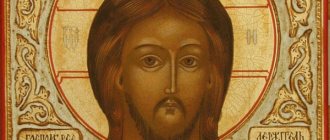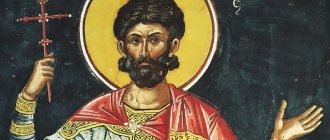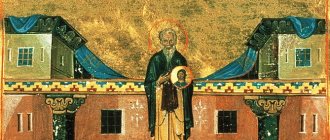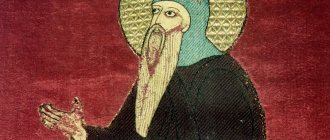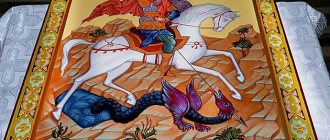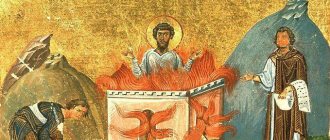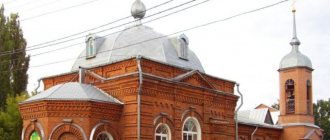The story of Saint Nikita
One of the first Christians, the Great Martyr Nikita, according to legend, was born into the family of the pagan Tsar Maximian, who was particularly cruel in dealing with the first Christian communities. Nikita more than once turned to his father with a request to convert to Christianity, but he, in a rage, tried to kill his son, and when this failed, he imprisoned him. In prison, a demon appeared to the future great martyr, albeit in the guise of an angel, and began to persuade the young man to renounce his chosen faith. Nikita began to pray to the Lord, and soon the Archangel Michael appeared to him, commanding him to test the devil. The young man grabbed the false guest, and, stepping on his neck, beat him with his own shackles.
The future great martyr spent three years in prison, and when the king called his son to repentance, the young man brought with him a defeated demon, proving to his father that it was the evil forces that controlled his heart. The king was inexorable and ordered his son to be executed, but God did not allow this. To prove the righteousness of the Christian faith and convert his father to Christianity, Nikita resurrected two people, and a little later, according to legend, baptized more than 18,000 people.
Evstafiy Plakida
It is difficult for a modern Christian to imagine that at the beginning of a new era many lives were laid down for faith in Jesus Christ, the Risen Savior.
People were ready to go through cruel trials, endure torture with fire and iron, part with earthly existence, but remain forever alive in the Kingdom of Heaven. For all generations, the holy martyrs remain an example of courage and faith, strengthening Orthodoxy in future centuries. Saint Eustathius Placidas, a great martyr of the second century, who was granted a meeting with Christ, like Job, endured all the trials, suffered martyrdom along with his family, but remained faithful to the Savior.
September 20 is the date of veneration of St. Eustathius in both Orthodoxy and Catholicism.
How do prayers to the Great Martyr Nikita help?
Many believers, offering a prayer to Saint Nikita for children, turn to him as a protector from demons and from seducing children’s souls. On the icons of the Great Martyr Nikita is depicted with shackles, with which he beats the Devil.
Prayer to Saint Nikita helps against damage, with various family troubles and with some illnesses, such as “relative”. The words of prayer will protect you from black magic, free you from slavery, and help you in your studies. Icons depicting the Saint beating the devil are customary to give to Nikitas on their name day, so that they will never be tempted by the Devil in their lives.
Memorial Day: September 28
It is necessary to read a prayer to Saint Nikita before going to bed, turning to the image on the icon, sincerely asking for his protection.
Reverence
In Orthodoxy and Catholicism, many churches were erected in honor of Saint Eustathius Placidus in the Christian world, one of the first was erected in the 7th century, but gained fame in the ninth century, this is the temple in Rome.
In eastern Georgia there is the Ertatsminda Temple. This name comes from the word “estatecmind”, that is, Saint Eustathius, who to this day is the guardian angel of the Georgian king, the holy martyr Luarsab the Second.
The great commander Giorgi Saakadze also considered the military leader Placidus the patron of the Georgian army. Thanks to the intercession of the great martyr, the Georgians won the battle of 1609 against the Turks; after the victory, the grateful warriors bowed their banners before the icon of the stratelates.
Eustathius-Placidas is revered in Rus' in the form of a warrior-martyr; he is often compared to the great Constantine the Great.
The Baptist of Rus', Vladimir the Great, was named by Nestor as the new Estathius-Placida, in whose honor the grandson of Prince Vladimir, the son of Mstislav of Chernigov, was named.
The Tatev monastery complex, which has survived until the present century, was built over the saint’s grave, on the site of a church.
Sint Eustatius is an island in the Caribbean, named after the great martyr Evstatheos.
Prayers to Saint Nikita Besogon
First prayer
O great passion-bearer of Christ and wonder-working Great Martyr Nikito! Falling before your holy and miraculous image, while your deeds and miracles and your many compassion for people are glorifying, we pray to you diligently: show us the humble and sinners your holy and powerful intercession, for it is a sin for our sake, not the imams of the freedom of the children of God, for our needs We boldly ask our Lord and our Master, but we offer you a favorable prayer book for him and we cry for your intercession, ask us from the Lord for beneficial gifts for our souls and bodies, right faith, undoubted hope of salvation, unfeigned love for everyone, courage in temptation, their patience in suffering, constancy in prayer, health of soul and body, fruitfulness of the earth, prosperity of the air, contentment of everyday needs, peaceful and pious life on earth, Christian death and a good answer at the terrible judgment of Christ. Also, O passion-bearer of Christ, from the Heavenly King ask our Russian country for peace, health and salvation, and against our enemies victory and victory, prosperity, silence and prosperity. Be a companion and helper against the enemies of the Christ-loving army, and show your holy intercession to all Orthodox people: heal the sick, comfort the sorrowing, help the needy. Hey, servant of God and long-suffering martyr! Do not forget your holy monastery and all the nuns and worldly people living in it and striving, but hasten to bear the yoke of Christ in humility and patience and graciously deliver them from all troubles and temptations. Bring us all into a quiet haven of salvation and make us worthy to be heirs of the blessed Kingdom of Christ through your holy prayers, so that we glorify and sing the great generosity of the Father and the Son and the Holy Spirit, in the Trinity we glorify and worship God, and your holy intercession forever and ever. Amen.
Second prayer
O great passion-bearer of Christ Nikito! Hear the prayer of us sinners, and deliver us (names) from all sorrow and adversity, from sudden death and from all evil: at the hour of separation of the soul from the body, passion-bearing, every evil thought and evil demons, so that our souls may be received in peace to the place of light, Christ the Lord our God, for from Him is the cleansing of sins, and He is the salvation of our souls, to Him belongs all glory, honor and worship, with the Father and the Holy Spirit, now and ever and unto ages of ages.
Great Martyr Eustathius Placis, his wife Theopistia and children Agapius and Theopist
Memorial Day: September 20
Martyrs Eustathius and Thekla
Before Baptism, the Holy Great Martyr Eustathius bore the name Placidas. He was a military leader under the emperors Titus (79 - 81) and Trajan (98 - 117). Not yet knowing Christ, Placidas did works of mercy, helping all the needy and suffering. The Lord did not leave the virtuous pagan in the darkness of idolatry.
Once, while hunting, he was chasing a deer on a fast horse, which stopped, running up a high mountain, and Placidas suddenly saw a shining Cross between its horns, and on it - the crucified Son of God. The amazed Placida heard a voice: “Why are you persecuting Me, Placida?” “Who are you, O Lord, who speaks to me?” - Placida asked in fear. And I heard in response: “I am Jesus Christ, God, who became incarnate for the salvation of people and endured free suffering and death on the Cross. You, without knowing Me, honor Me, for your good deeds and abundant alms have reached Me. I appeared here to convert and join you to My faithful servants. For I do not want a person who does righteous deeds to perish in the snares of the enemy.”
Placidas exclaimed: “Lord, I believe that You are the God of Heaven and earth, the Creator of all creatures. I pray to You, Lord, teach me what to do.” And again the Divine voice sounded: “Go to a Christian priest, receive Baptism from him, and he will guide you to salvation.”
Miracles of healing
The Venerable Stylite, whose life ranged from sinful pastimes to complete repentance and the feat of stylite, became a local landmark. The rumor about the healing abilities of the Stylite reached the lands of the Grand Duke of Chernigov, Mikhail Vsevolodovich, who suffered from leg disease from birth.
The prince decided to go to the monk for healing. On the way to Pereslavl, the princely retinue stopped to rest, setting up camp tents. Soon a monk from a nearby monastery approached the tent city and saddened the prince with his statement that Nikita was a simple flatterer and deceiver, and it was in vain to expect help from him.
After the departed monk, the next one appeared, he again repeated the words of the previous wanderer, but the prince continued on his way, the next stop was just before Pereslavl, the boyar Theodore went to the Stylite, but before that an elderly peasant with a shovel approached the prince’s tent, saying that the old man had died, and he personally buried him, this is how Satan stopped pilgrims.
To personally see the grave of the Stylite, boyar Theodore hurried to the monastery, where he was met by the monk in a pillar, with metal chains and a stone cap, in prayer.
Hagiographic icon of Nikita of Pereslavl (stylite)
The subsequent actions of the Venerable Stylite surprised the boyar, for the elder gave his own staff to the prince, who was weak with his feet, ordering him to personally appear at the monastery.
Joy and surprise filled the tent at the moment when the prince, taking the staff in his hands, immediately took his first steps and was able to reach the monastery. Historians have recorded the miracle of the healing of Prince Mikhail Vsevolodovich on May 16, 1186.
In 1702, a chapel was erected on the site of the prince’s tent near Chernigov, in which he received healing.
Great Battle
However, the light of Christ was not allowed to shine for long in the Gothic country. Soon the wicked prince Phanaric ascended the throne, who, driven by anger and envy towards the zealots of the Christian faith, ordered the killing of all the heralds of the Savior's teachings. The Goths were divided into two opposing camps. The first was headed by a certain Fritigern, who was a true preacher of Christ. The second camp was taken under the command of a fierce persecutor of Christians named Athanaric. In the country where the saint lived, a great bloody battle took place, as a result of which the Christians won. Athanaric fled in great disgrace, and the faith of Christ became even more widespread among the Goths.
Saint Nikita also gave a lot of strength so that the teachings of Christ would enter every home of his fellow tribesmen. His pious life for many Goths was an example of true Christian piety.
After the death of Bishop Theophilus, Urfil took his place at the department. Being a prudent husband, he invented writing for the inhabitants of his native country and translated many Christian books from Greek into Gothic.
Biography
Yuri Dolgoruky inherited the Rostov-Suzdal land and began to build cities of God, monasteries and temples. Having visited a monastic monastery near Lake Pleshcheevo while touring the lands, the prince wished to build a stone church in the town in honor of the Transfiguration of the Lord on the banks of the Trubezh River.
The great princely plans were not destined to come true during the prince’s lifetime; the sudden death of Yuri Dolgorukov caused the construction of the city and the temple to stop. His father’s work was continued by his son, Prince Andrei Bogolyubsky, under whose reign the church in Pereslavl was consecrated.
Construction required increased costs, which were covered by taxes, which placed an unbearable burden on the shoulders of the Pereslavl residents. To collect taxes, cruel people were required who had no pity for the inhabitants of the town. The most cruel among the collectors was Nikita, who, in parallel with collecting taxes, managed to rob people for his own profit.
Venerable Nikita Stylite
His resourceful mind always helped him get away with any situation; the collector bought the city authorities with luxurious feasts and valuable gifts. For several years, a selfish, greedy tax collector terrorized the city until the Lord Himself took hold of the sinner, wanting to save him for the glory of God.
Miracle of Repentance
Like all Russian people, Nikita went to church from time to time, and one day a sinful soul was touched by words from the book of Isaiah (Is. 1:16-17), that one must cleanse oneself from wickedness for purity, and always do good, first and foremost turn protecting the orphan and the widow.
The cruel heart of the sinner was literally filled with repentance; looking at the holy images, the once cruel executioner saw the faces of the people oppressed by him. Along with church singing, the groans and cries of the disadvantaged stood in the sinner’s ears. Nikita's heart fluttered as he rushed out of the church; he ran home, where he spent the night without sleep.
The next morning, trying to forget, the tax collector gathers his former friends for a merry feast, but what happened in his kitchen changed the sinful soul forever. During the feast, a cry was heard from the tax collector's wife standing at the stove; the owner rushed to the cauldron and saw parts of a human body floating in it in blood.
The sinner realized that he was behaving like a murderer; in despair and fear, he fled from home to the men's monastery. Falling at the feet of the abbot, the once cruel tax collector began to ask for the salvation of his soul. In order to test the humility and sincerity of the repentant sinner, the abbot ordered him to repent for his sins before everyone who entered for three days near the monastery gates.
The monk sent three days later did not find the sinner near the gate, but found a bitten body covered with midges and blood in the swamp. The voluntary sufferer conquered the heart of the abbot with humility and obedience, who washed him and performed monastic tonsure.
Feat of pillarism
Realizing the gravity of the iniquities committed in a past life, the young monk puts on huge iron chains and a hat carved from stone. He spends all day and night in prayer and fasting.
Chains of St. Nikita the Stylite
At first, the monk dug wells for living, and then tightened his living, digging a round hole in the form of a pillar, where he mortified his flesh from passions and was filled with the spirit of God. Confirmation that the Almighty accepted the monk’s sacrificial repentance was the gift of healing the sick and freeing the addicted.
About other saints:
- John Cassian the Roman
- Saints Cyprian and Justinia
- Epiphanius the Wise
